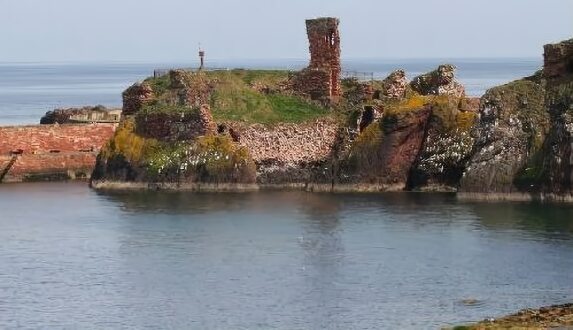Great-grandson of the Saxon king Ethelred the Redeless
Gospatric was born about 1037, he was the great-grandson of the Saxon king Ethelred the Redeless, through his mother Ealdgyth, whose own mother, Ælfgifu, who had married Uchtred the Bold, ealdorman of Northumbria. His paternal ancestry is uncertain. Simeon of Durham stated that Gospatric was the son of Cumbrian 'Prince' Maldred by his wife Ealdgyth of Bamburgh. Maldred himself was the son of Crínáin, Abbot of Dunkeld, and Bethoc, the daughter of Scottish King Malcolm II. Gospatric is a British Celtic name meaning 'Servant of St. Patrick'.
Bamburgh Castle
Following his victory at the Battle of Hastings, in early 1067, William the Conqueror appointed Copsig as Earl of Bernicia. Copsig, whose family had a history of being rulers of Bernicia, had been a supporter of Tostig Godwineson, the unruly brother of King Harold II, Copsig had shared Tostig's exile in 1065.
Within five weeks, Copsig had been killed by Oswulf, a grandson of Uchtred the Bold, Earl of Northumbria, Oswulf then installed himself as Earl. Oswulf himself was killed by bandits after spending less than six months as Earl. Gospatric, who was probably a relative of both Oswulf and Uchtred, possessed a plausible claim to the Earldom, offered King William a large amount of money to be granted the Earldom of Bernicia, which Wiliam accepted.
In early 1068, Gospatric joined in a rebellion against the Conqueror, allied with Edgar Ætheling, the Anglo-Saxon claimant to the throne, and Edwin, Earl of Mercia and his brother Morcar. The rebellion failed and William dispossessed many of the northern landowners and granted the lands to Normans. Gospatric forfeited his earldom to the Fleming Robert Comine and went into exile in Scotland. Despite local rebellions such as those of the heroic Hereward the Wake in East Anglia and that of Eadric the Wild in Herefordshire, William continued to extend his authority over England with an iron fist.
The following year, Gospatric joined the invading army of Danes, Scots, and Englishmen under Edgar the Aetheling, the last representative of the old Saxon House of Wessex, who had a strong claim to be the heir of Edward the Confessor. Despite warnings from Bishop Ethelwin, that a rebel army had mobilised against him, Robert Combine, the new Earl of Northumbria, rode into Durham with a small force on 28 January 1069, where he and his men were surrounded and slaughtered. The rebels then turned their attention to York where they killed the guardian of the castle.
Dunbar Caastle
William's response was swift and brutal, in what has come to be known as the 'Harrying of the North', Norman massacres ensued and William ravaged York and its church, he fell on the besiegers, killing or putting them to flight and then marched to the River Tees, ravaging the surrounding countryside as he proceeded north.
Gospatric was able, due to his holding Bamburgh Castle, to make terms with the king, Edgar fled to Scotland, where Malcolm III, King of Scots was married to his sister Margaret. Waltheof, Earl of Northumbria, who had joined the revolt, submitted to William, along with Gospatric, and both were pardoned and allowed to retain their lands, Gospatric's earldom was re-instated. But William's vengeance was not satiated, he marched over the Pennines during the winter and defeated the remaining rebels at Shrewsbury. The Anglo-Norman chronicler Orderic Vitalis stated in his Ecclesiastical History:-
"The King stopped at nothing to hunt his enemies. He cut down many people and destroyed homes and land. Nowhere else had he shown such cruelty. This made a real change. To his shame, William made no effort to control his fury, punishing the innocent with the guilty. He ordered that crops and herds, tools and food be burned to ashes. More than 100,000 people perished of starvation. I have often praised William in this book, but I can say nothing good about this brutal slaughter. God will punish him."
In 1072 William the Conqueror again stripped Gospatric of his Earldom of Northumbria, and replaced him with Waltheof, 1st Earl of Northampton, the son of Siward the Strong. Gospatric fled into exile in Scotland and soon afterwards went to Flanders. When he returned to Scotland he was granted Dunbar Castle and the adjacent lands in Lothian, (later to become the Earldom of Dunbar) by Malcolm Canmore, King of Scots, who was probably Gospatric's uncle. He rebuilt the wood and wattle Fortress of Bar into the stone castle of Dunbar, which was to become one of the mightiest castles in Scotland.
Gospatric did not live long in Scottish exile, Roger of Hoveden's chronicle relates:-
"[N]ot long after this, being reduced to extreme infirmity, he sent for Aldwin and Turgot, the monks, who at this time were living at Melrose, in poverty and contrite in spirit for the sake of Christ, and ended his life with a full confession of his sins, and great lamentations and penitence, at Ubbanford, which is also called Northam, and was buried in the porch of the church there.
Gospatric left three sons, his eldest son Dolfin, was given the government of Carlisle by Malcolm Canmore but was expelled from his position by the Conqueror's successor, William Rufus. The second son, Gospatric II, Earl of Dunbar, was killed at the Battle of the Standard in 1138 but left four sons, the descendants of the eldest of these, Gospatric III, Earl of Lothian or Earl of Dunbar, were to become one of the most powerful families in Scotland, the Earls of Dunbar and March controlled much of Lothian and all of the Borders. Gospatric's youngest son, Waltheof, became Lord of Allerdale and Abbot of Crowland.
Among Gospatric's male-line descendants were the Neville family, immensely powerful in the north of England during the middle ages. He also left at least one daughter, Uchtreda, who married Duncan II of Scotland, the son of King Malcolm Canmore. This marriage produced one son, William FitzDuncan, who was born around 1094.
Hereward the Wake PreviousNext Matilda of Flanders
